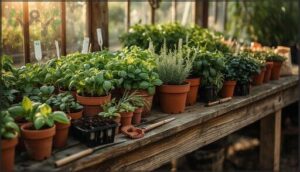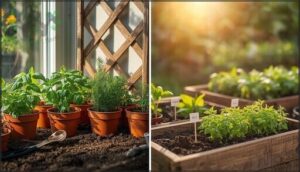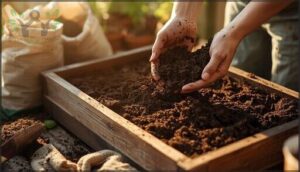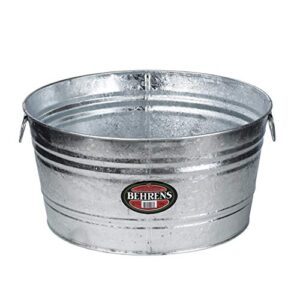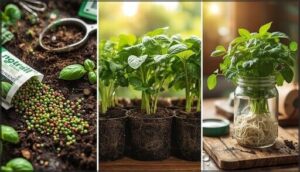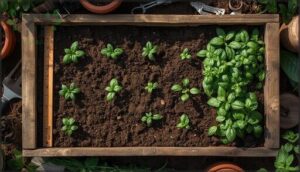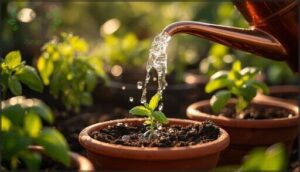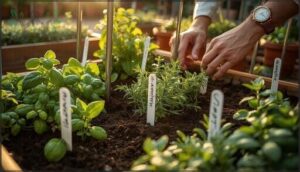This site is supported by our readers. We may earn a commission, at no cost to you, if you purchase through links.
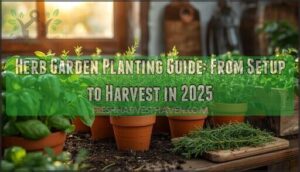
That glossy basil from the grocery store wilts before you finish your recipe, and those pre-packaged herbs cost three times what a living plant would. Growing your own herb garden solves both problems while giving you restaurant-quality ingredients steps from your kitchen.
Whether you’re working with a sunny windowsill or a backyard plot, herbs are forgiving plants that reward even beginners with explosive growth and bold flavors. Most culinary favorites need just six hours of sunlight and basic care to thrive.
You’ll master the essentials—from choosing between annuals like basil and perennials like rosemary to preparing soil that drains properly—so your first harvest arrives in weeks, not months.
Table Of Contents
- Key Takeaways
- Why Start an Herb Garden at Home
- Choosing The Right Herbs to Plant
- Selecting Your Garden Location and Setup
- Preparing Soil for Herb Planting
- Top 5 Products for Your Herb Garden
- Step-by-Step Herb Planting Instructions
- Caring for and Harvesting Your Herbs
- Frequently Asked Questions (FAQs)
- What is the best layout for an herb garden?
- Which herbs should not be planted together?
- What time of year should I plant an herb garden?
- What herbs grow well together chart?
- Can herbs survive winter temperatures outdoors?
- How much does herb gardening typically cost?
- Which herbs grow fastest from seed?
- Do herbs need special lighting indoors?
- What causes herbs to lose their flavor?
- How to companion plant herbs with vegetables?
- Conclusion
Key Takeaways
- Growing your own herbs cuts grocery costs by $20–$50 per perennial plant while delivering peak flavor that store-bought varieties can’t match, with most culinary favorites ready to harvest in just 45–80 days.
- Herbs thrive in minimal space with basic care—six hours of sunlight, well-draining soil mixed with compost, and watering once or twice weekly—making them ideal for beginners working with windowsills or small containers.
- Choose perennials like rosemary, thyme, and oregano for years of harvests without replanting, or opt for fast-growing annuals like basil and cilantro if you want quick results within weeks.
- Harvest correctly by snipping no more than one-third of the plant at a time in early morning, and preserve excess herbs through freezing or drying to maintain flavor for up to a year.
Why Start an Herb Garden at Home
Growing your own herbs at home isn’t just a trend—it’s one of the smartest moves you can make for your kitchen and your wallet. Whether you’re working with a sprawling backyard or a sunny windowsill, herbs adapt to just about any space you can offer them.
Let’s look at three solid reasons why starting an herb garden deserves a spot on your to-do list this year.
Freshness and Flavor in Your Cooking
Nothing beats the flavor intensity you get from just-harvested herbs. When you snip fresh basil or thyme moments before cooking, you capture peak herb aroma and culinary impact that store-bought varieties simply can’t match.
Freshly snipped herbs deliver unmatched flavor and aroma that store-bought varieties can’t replicate
Chefs prefer fresh culinary herbs for good reason—they deliver bright, complex flavor that transforms ordinary dishes. Your herb varieties will release natural oils that boost depth, making every meal taste restaurant-quality.
To maintain this freshness, be sure to remember optimum storage conditions.
Cost Savings and Year-Round Availability
Beyond the flavor, you’ll see real grocery bill reduction when growing herbs at home. A single perennial herb savings of $20 to $50 per plant adds up fast—especially with rosemary or thyme.
Indoor herb gardens extend your harvest through winter, offsetting seasonal price spikes. You’ll also cut down on packaging waste while reducing food waste by harvesting exactly what you need.
Plus, you can also enjoy the health benefits of herbs.
Low-Maintenance Plants for Any Space
Herbs fit anywhere—you don’t need a green thumb or much time. Here’s why they work in tight spots:
- Minimal watering – Oregano and mint handle missed waterings without wilting
- Sunlight adaptability – Chives and thyme thrive with just 2 to 6 hours of light
- Pest resistance – Rosemary and sage rarely need sprays or fussing
- Continuous harvest – Basil matures in six weeks, then keeps producing
Container gardening means growing herbs on a balcony or windowsill with zero yard required.
Choosing The Right Herbs to Plant
Not all herbs are created equal, and knowing which type you’re planting makes a world of difference in how you care for them. Some herbs come back year after year, while others need replanting every season or two.
Let’s break down the main categories and highlight a few beginner-friendly options to get you started.
Annual Herbs: Basil, Dill, and Cilantro
If you’re looking for fast results, annual herbs like basil, dill, and cilantro won’t disappoint. Basil seeds germinate in 5 to 10 days when soil hits 70°F, while cilantro and dill sprout within 7 to 14 days.
You’ll harvest basil in 45 to 60 days, dill in 40 to 60 days, and cilantro in roughly 80 days—with multiple cuttings possible all season.
Perennial Herbs: Rosemary, Thyme, and Oregano
For a garden investment that pays off year after year, perennial herbs like rosemary, thyme, and oregano are hard to beat. These culinary powerhouses thrive in zones 4–10, producing fresh leaves and essential oils without replanting.
Rosemary yields an average of 20 tons per hectare annually, while thyme delivers 6,000 kg of fresh material. You’ll propagate them by seed, cutting, or division—giving your herb garden serious economic viability.
Biennial Herbs: Parsley and Caraway
Unlike their annual cousins, biennial herbs like parsley and caraway take two years to complete their lifecycle—but patience pays off. Parsley forms a sturdy leaf rosette in year one before flowering, while caraway delivers impressive seed yields (about one-third cup per plant) in year two.
Watch for carrot weevils on parsley; they’ve destroyed entire crops. Harvest caraway seeds when they turn brown in late summer.
Best Herbs for Beginners
Your starter kit of beginner plants should lean toward chives, basil, and mint—three champions that forgive watering lapses and deliver generous harvests. When planting herbs for your first herb garden, focus on easy-growing varieties with low maintenance needs:
- Chives tolerate neglect and regrow within two weeks after cutting.
- Basil achieves 95% germination rates and yields 500 grams per plant.
- Mint thrives in containers, producing up to 700 grams seasonally.
Selecting Your Garden Location and Setup
Before you plant a single basil seed, you need to figure out where your herbs will actually live. The right spot can mean the difference between a thriving garden and a handful of sad, leggy stems.
Let’s walk through the key decisions that’ll set you up for success from day one.
Sunlight and Space Requirements
Most culinary herbs need at least 6 hours of direct sunlight daily to thrive. Rosemary, oregano, and basil love even more—7+ hours for maximum leaf production.
When planning your garden layout, give basil, dill, and thyme 12 inches of plant spacing. Cilantro and mint need 18 inches.
Proper container size and light exposure directly affect flavor intensity and harvest yields.
Indoor Vs. Outdoor Growing Options
Both indoor gardening and outdoor gardening offer distinct advantages for growing herbs. Here’s how they stack up:
- Yield Comparison: Outdoor herbs produce over 1 kg annually per plant, while indoor varieties reach 80% of outdoor growth rates.
- Climate Control: Indoor temps stay consistent at 65-70°F, preventing the 40% seasonal crop loss outdoors.
- Pest Differences: Outdoor gardens face twice the pest pressure.
- Light Requirements: Indoor setups need grow lights; outdoor herbs get free sunlight.
- Space Constraints: Indoor gardens fit in 1 square foot; outdoor beds need 10-20 square feet.
Choose based on your available space and growing conditions.
Container Vs. In-Ground Planting
Choosing between container gardening and in-ground planting shapes your herb garden success. Containers offer excellent soil drainage and cost efficiency—starting around $25–$80—but face root restriction that cuts yield by 20–40%. They need 2–3 times more watering yet show lower disease incidence.
In-ground beds amplify sunlight requirements naturally, deliver 15–35% higher yields, and reduce water usage, though they invite more soil-borne issues.
Choosing The Right Container Size and Material
Once you’ve settled on containers, selecting herb containers means matching pot volume to root depth. Most herbs need at least 6-inch depth, but basil and parsley prefer 8 inches. A 3-gallon pot suits chives; rosemary thrives in 7-gallon sizes.
Material impacts drainage needs—plastic retains moisture for cilantro, while terra cotta’s excellent soil drainage benefits thyme. Overcrowding risks fungal issues, so give each plant adequate soil volume.
Preparing Soil for Herb Planting
Good soil is the foundation of a healthy herb garden—it’s where your plants will draw nutrients, anchor their roots, and thrive for months to come. Most herbs aren’t picky, but they do need soil that drains well and doesn’t stay soggy.
Let’s walk through the key steps to mix and prep soil that’ll set your herbs up for success.
Creating Well-Draining Soil Mix
A proper soil mix makes the difference between herbs that thrive and ones that struggle. Your goal is a blend that drains quickly while holding just enough moisture to keep roots happy.
Here’s what goes into a winning mix:
- Combine equal parts potting soil, perlite, and compost for balanced drainage and nutrients
- Aim for 50–60% drainage materials like coarse sand or grit in your soil mix
- Keep soil pH between 6.0 and 7.0 for best root growth
- Test drainage by watering—it should drain in 30 seconds to 2 minutes
- Refresh container soil every six months to maintain drainage capacity
Adding Compost and Organic Matter
Compost works like a slow-release vitamin for your herb garden. Mix 2 to 3 inches into the top 6 inches of soil before planting—that’s your sweet spot for soil organic matter between 5% and 15%. You’ll see faster growth, better flavor, and healthier plants.
Use food scraps, yard waste, or quality bagged compost as your input sources for maximum soil health benefits.
Avoiding Over-Fertilization for Better Flavor
While compost feeds your herbs gradually, synthetic fertilizers can backfire fast. Too much nitrogen pushes leafy growth but dilutes flavor by up to 45% in basil and thyme. That’s why soil testing before you fertilize herbs matters—you’ll avoid nutrients overkill and protect plant health. Stick to low-nitrogen formulas (5-10-10) and follow package rates. Your harvest will taste worlds better.
- Apply fertilizer in early spring when herbs break dormancy, not during active growth peaks
- Choose organic options like diluted fish emulsion over high-nitrogen lawn fertilizers
- Watch for yellowing leaves and tip burn—classic signs you’ve overdone the nutrients
- Let soil dry slightly between waterings to prevent fertilizer salt buildup and root damage
Top 5 Products for Your Herb Garden
You don’t need to break the bank to get your herb garden thriving. A few well-chosen tools and resources make the difference between struggling plants and a productive harvest.
Here are five products that’ll set you up for success from day one.
1. Round Hot Dipped Steel Tub
If you’re looking for a container that will outlast most garden beds, hot-dipped steel tubs deliver. With a steel tub lifespan over 20 years, they resist rust and rodent damage while maintaining environmental sustainability through recyclability.
The metal sides provide excellent soil temperature regulation, warming your herb garden soil up to two weeks earlier in spring. Container portability means you can chase the sunlight, and ergonomic gardening becomes easier with built-in grips.
They’re practical, durable, and perfect for serious herb planting.
Best For: Gardeners who want a durable, long-lasting container for herbs or small plants that can handle outdoor weather and be moved around as needed.
- Lasts over 20 years thanks to rust-resistant hot-dipped steel construction that handles freeze-thaw cycles and blocks rodents
- Warms soil up to two weeks earlier in spring, extending your growing season and giving herbs a healthier start
- Portable design with handles lets you move it to follow the sun or rearrange your space without breaking your back
- Some units arrive with sharp edges or rough handles that need smoothing before safe handling
- A few customers reported leaks from bottom holes, though these can usually be fixed with caulk
- Plain industrial look won’t appeal to anyone wanting decorative or eye-catching garden containers
2. AeroGarden Bounty Basic Indoor Garden
Your indoor herb garden gets a high-tech boost with the AeroGarden Bounty Basic. This hydroponic garden uses automated features to grow up to nine herbs simultaneously, with plants maturing five times faster than soil methods.
The 30-watt LED system and built-in reminders for water and nutrients take the guesswork out of indoor gardening. Cost analysis shows the initial $180 investment delivers year-round harvests, making it practical for serious herb growers.
The hydroponic technology means no soil mess, and the 24-inch grow height accommodates larger varieties—AeroGarden benefits that transform kitchen countertops into productive growing spaces.
Best For: Home cooks and apartment dwellers who want fresh herbs year-round without outdoor garden space or dealing with soil.
- Grows up to 9 plants at once with a spacious water reservoir that needs less frequent refills than smaller models
- Plants grow 5 times faster than soil and sprout in as little as 5 days, giving you fresh harvests within weeks
- Automated reminders and vacation mode handle the hard work, making it nearly foolproof for beginners
- Replacement seed pods add up quickly and can make long-term costs higher than expected
- Some users report pods that fail to germinate, which is frustrating when you’re paying premium prices
- Takes up significant counter space and the 30W LED light runs constantly during grow cycles
3. Alaska Fish Emulsion Plant Food Fertilizer
Your herb garden thrives when you feed it right, and Alaska Fish Emulsion delivers with a 5-1-1 NPK ratio that won’t burn tender leaves. This OMRI-certified organic fertilizer pumps nitrogen into your soil mix, boosting leaf production without harsh chemicals.
Application rates are simple—one tablespoon per gallon every three weeks keeps basil, parsley, and thyme growing strong. Studies show 18% better leaf mass compared to unfertilized herbs, proving its efficacy for growth.
With 67% market adoption among U.S. organic gardeners, it’s a trusted choice for planting success.
Best For: Organic gardeners who want a proven, OMRI-certified liquid fertilizer that delivers steady nitrogen for lush herb foliage without risking leaf burn.
- 5-1-1 NPK formula provides nitrogen-rich feeding that boosts leaf growth by an average of 18% compared to unfertilized herbs, perfect for basil, parsley, and cilantro.
- OMRI-certified organic and safe for indoor and outdoor use—won’t burn plants when diluted properly at 1–3 tablespoons per gallon every three weeks.
- Deodorized with wintergreen to reduce the typical fishy smell, plus it enhances soil microbial activity and restores trace minerals like iron, zinc, and copper.
- Strong odor still present despite deodorizing—some users find the smell unpleasant, especially when applying indoors or in enclosed spaces.
- Requires careful dilution and application to avoid leaf burn if applied directly to foliage or blooms, adding an extra step to your routine.
- 1-gallon size can be bulky to store and may feel pricey compared to synthetic alternatives, though it’s a leading organic option in the U.S. market.
4. DK Encyclopedia of Herbal Medicine
Growing your herb garden means more than planting herbs—it’s about understanding remedy efficacy and global impact. The DK Encyclopedia of Herbal Medicine profiles over 560 medicinal plants with detailed preparation methods and dosage guidelines for 150 ailments.
You’ll master herb identification through 100 full-page entries showing habitat, uses, and chemical constituents. This herb planting guide transforms beginners into confident herbalists, with evidence-based remedies supported by clinical trials.
At 336 pages, it’s your reference for choosing herbs that heal and thrive in any garden.
Best For: Self-sufficient herbalists, natural medicine practitioners, and anyone interested in growing and preparing their own herbal remedies with evidence-based guidance.
- Comprehensive coverage of over 560 medicinal plants with detailed profiles, preparation methods, and dosage guidelines for nearly 150 ailments, making it a complete reference for beginners and experienced practitioners.
- Evidence-based approach that includes clinical trial data and research findings, helping you understand which remedies actually work and how to use them safely.
- Practical cultivation advice with full-page entries on 100 key herbs showing exactly how to grow, harvest, and prepare each plant for medicinal use.
- Large size makes it less portable and harder to reference quickly in the garden or workspace compared to smaller field guides.
- Technical medical terminology throughout may be challenging for complete beginners without some basic knowledge of anatomy or herbalism.
- Hardcover binding can fall apart with heavy use—the spiral-bound version is more durable but costs more and may not be available everywhere.
5. Southwest Medicinal Plants for Health Wellness
The Southwest’s wild spaces hold 112 medicinal herbs waiting to be discovered—if you know where to look. Southwest Medicinal Plants for Health Wellness teaches ethical harvesting and traditional usage through clear color photos and seasonal foraging lists.
You’ll learn herbal preparations like teas and tinctures while identifying species with proven economic impact. At $20.49, this guide bridges your herb garden with desert wisdom, showing how growing herbs connects to remedies that Southwest communities have trusted for generations. Perfect for expanding your medicinal plant ID skills.
Best For: Foragers, herbalists, and naturalists in the Southwest who want to identify wild medicinal plants, harvest them ethically, and create their own herbal remedies like teas and tinctures.
- Covers 112 medicinal plants with clear color photos and seasonal foraging lists, making identification straightforward even for beginners.
- Provides practical guidance on making herbal preparations including teas, tinctures, and salves with step-by-step instructions.
- Emphasizes safe and ethical harvesting practices to protect wild plant populations while connecting you to traditional Southwest healing knowledge.
- The index may be difficult to navigate, and the organizational structure might not suit everyone’s preferences.
- Some plant information may not apply to your specific location within the broader Southwest region.
- You’ll likely need additional resources or local guides to fill in gaps for your particular area.
Step-by-Step Herb Planting Instructions
You’ve got your soil ready and your herbs picked out—now it’s time to get them in the ground. Whether you’re starting from seed, transplanting seedlings, or rooting cuttings, the planting process is straightforward once you know the basics.
Let’s walk through exactly how to get each herb settled in so it can thrive from day one.
Starting From Seeds, Seedlings, or Cuttings
You’ve got three solid paths forward: seeds, seedlings, or cuttings. Seeds cost 50–70% less but need patience—think 8–12 weeks to harvest. Seedlings offer 70–85% survival rates and cut that time by a month. Cuttings? They’re fast (6–8 weeks) and guarantee genetic crop uniformity, but expect around 50% success. Choose based on your timeline and comfort level.
Proper Spacing and Planting Depth
Once you’ve chosen your method, spacing and soil depth become your foundation. Think of it like this: herbs need breathing room to avoid fungal issues and reach their full harvest yield.
- Basil, rosemary, and thyme: Space 12 inches apart
- Parsley and oregano: Allow 6 inches minimum
- Mint and cilantro: Give 18 inches for spreading
Most herbs need 6–12 inches of soil depth—deeper-rooted varieties like parsley and dill perform best at 12 inches.
Watering After Planting
Once your herbs are nestled at the right depth and spacing, watering correctly sets the stage for root development and harvest success. Water deeply until moisture reaches one inch below the surface—this kick-starts strong root systems. For the first week, water daily to help transplants settle in. After that, shift to once or twice weekly, letting the top inch of soil dry between sessions.
Check soil moisture by poking your finger down two inches—if it feels dry, it’s time to water. This simple habit prevents the overwatering trap that causes up to 80% of herb failures. Morning irrigation reduces evaporation and lets leaves dry before nightfall, cutting fungal risks. Container herbs need water until it drains from the bottom, ensuring even saturation without leaving roots sitting in standing water.
Different herbs have unique water requirements. Basil and mint crave consistent moisture, while rosemary and thyme thrive in drier conditions. Adjust your watering frequency based on rainfall, temperature, and how vigorously your plants are growing. Deeper, less frequent watering beats daily spritzes—it encourages roots to reach down rather than hover near the surface, building drought resilience for a thriving herb garden.
| Watering Stage | Frequency | Volume/Depth |
|---|---|---|
| First week (seedlings/transplants) | Daily (light) | Surface moist, not soggy |
| Weeks 2–4 (establishment) | 1–2 times per week | 1 inch deep or 100ml |
| Mature herbs (ongoing) | Weekly or as soil dries | 1 inch of water per week |
| Drought-tolerant herbs (rosemary, thyme) | Less frequent | Allow soil to dry fully between waterings |
Labeling Your Herbs
After watering, grab your plant tags or garden markers—proper herb identification saves you from costly mistakes. Label materials matter: plastic labels stay legible for up to five years, while metal plant tags last over a decade without fading.
Include both common and botanical names on your herb garden design. Without labels, misidentification rates in herb cultivation hit 24%, leading to wasted harvests and confusion.
Caring for and Harvesting Your Herbs
Once your herbs are in the ground, the real work begins—but don’t worry, it’s easier than you think. A few simple habits will keep your plants thriving and producing fresh leaves all season long.
Let’s walk through the essentials of watering, feeding, pest control, and getting the most out of every harvest.
Watering and Fertilizing Schedule
Think of watering and fertilizing your herb garden like feeding yourself—consistency matters more than excess. Check soil moisture weekly, then water 1–2 times based on dryness. Most herbs need 1–2 inches weekly.
Use organic fish emulsion at half-strength monthly during active growth for nutrient balance. Deep irrigation systems work best, keeping roots healthy without waterlogging.
You’ll harvest herbs with better flavor when you avoid over-fertilization.
Pruning to Encourage Growth
Regular pruning techniques transform your herb garden from scraggly to abundant. Trim no more than 33% of each plant at once—this sweet spot triggers leaf regeneration and extends your harvest optimization window by weeks.
- Pinch basil weekly to promote bushier growth and prevent early flowering
- Cut perennials like rosemary 30–40% in early spring for plant renewal
- Snip outer leaves first on parsley and chives to maintain continuous production
Smart plant care means more harvesting herbs throughout the season.
Managing Aphids and Common Pests
Spot tiny green bugs on your basil? That’s an early aphid warning. For smart Aphid Control, blend Pest Management with Organic Solutions—like insecticidal soap or releasing ladybird beetles.
Biological Methods work wonders, but Integrated Strategies—scouting, removing weeds, and encouraging beneficial bugs—keep pests from taking over.
Stay vigilant, and you’ll harvest herbs from a thriving, healthy herb garden all season.
When and How to Harvest
Snip your basil once it hits 4 to 6 inches tall—that’s your green light for Harvest Timing. Use clean scissors for Herb Cutting just above a leaf node to spark bushy Regrowth Techniques.
Harvest herbs in early morning after dew dries for peak flavor. Pinch off up to a third of the plant’s Leaf Removal without stressing it, and handle gently during Post Harvest Handling to lock in freshness.
Drying and Freezing for Preservation
Freeze drying locks in more flavor than air drying herbs, though both work well for herb preservation. Hang bundles in a warm, dry spot for three to four days, or freeze tender basil and mint in ice cube trays with oil.
Dried herbs pack three times the punch of fresh, so adjust your recipes. Store dehydrated herbs in airtight jars for up to a year.
Frequently Asked Questions (FAQs)
What is the best layout for an herb garden?
Think of your herb garden design as a recipe—the right layout blends function with beauty.
Start with a simple quadrant system or raised beds grouped by sunlight needs, water requirements, and companion planting relationships for accessible, productive small spaces.
Which herbs should not be planted together?
Keep fennel isolated—it stunts nearby herbs through allelopathic effects. Mint spreads aggressively, crowding out companions.
Sage and basil clash due to moisture needs. Rue harms basil growth.
Smart herb companion planting means respecting natural incompatibilities.
What time of year should I plant an herb garden?
Start your herb garden in early spring after the last frost, when soil temperatures reach 70°F.
In mild climate zones, you can plant herbs year-round.
Indoor herb planting works anytime, bypassing outdoor growing seasons entirely.
What herbs grow well together chart?
Picture your herb garden as a neighborhood where some plants are best friends while others are tricky roommates.
Use companion planting charts to pair Mediterranean herbs like rosemary and thyme together for thriving garden layout success.
Can herbs survive winter temperatures outdoors?
Many perennial herbs survive winter outdoors with proper frost protection. Thyme, oregano, and sage tolerate subzero temperatures, while rosemary needs mulching or cold frames.
Annual herbs require indoor overwintering to survive freezing conditions.
How much does herb gardening typically cost?
Initial costs run $20 to $50 for indoor setups or $50 to $100 for outdoor gardens.
Ongoing expenses—seed prices, fertilizer costs, and maintenance budget—usually stay under $100 annually once your herb garden is established.
Which herbs grow fastest from seed?
Dill, basil, and cilantro are the fastest herbs to grow from seed, reaching harvest in 40 to 60 days. These annual varieties offer quick germination and rapid seedling growth for impatient gardeners.
Do herbs need special lighting indoors?
Herbs require 6 hours of direct sunlight daily or 12–16 hours of artificial light indoors.
LED and fluorescent grow lights work best, providing the right intensity and spectrum for healthy growth without excess heat.
What causes herbs to lose their flavor?
Think of flavor as sunshine trapped in leaves. Water stress, poor soil quality, and light exposure damage those aromatic oils.
Physical damage from rough harvesting or genetic variation also weakens taste in your herb garden.
How to companion plant herbs with vegetables?
Companion planting pairs herbs with vegetables to boost yields, reduce pests, and attract beneficial insects. Basil near tomatoes, rosemary with beans, and dill alongside cabbage create thriving gardens with healthier soil and fewer chemical interventions.
Conclusion
Sure, you could keep buying those $4.99 plastic clamshells of wilted basil that last exactly one recipe. Or you could follow this herb garden planting guide and grow enough oregano to supply a small Italian restaurant.
Your windowsill doesn’t judge your cooking skills—it just grows what you plant. Six weeks from now, you’ll wonder why you ever paid grocery-store prices for herbs that taste like the package they came in.
- https://www.rainbowgardens.biz/edibles/when-to-plant-herbs-san-antonio-harvesting-tips/
- https://mgnv.org/plants/veg-herbs/seasonal-guide-growing-herbs/
- https://www.facebook.com/groups/homesteadingforbeginners/posts/2538051056392263/
- https://humboldtssecretsupplies.com/blogs/articles/best-soil-for-herbs-everything-you-need-to-know
- https://extension.wvu.edu/lawn-gardening-pests/gardening/gardening-101/herb-gardening-for-beginners

